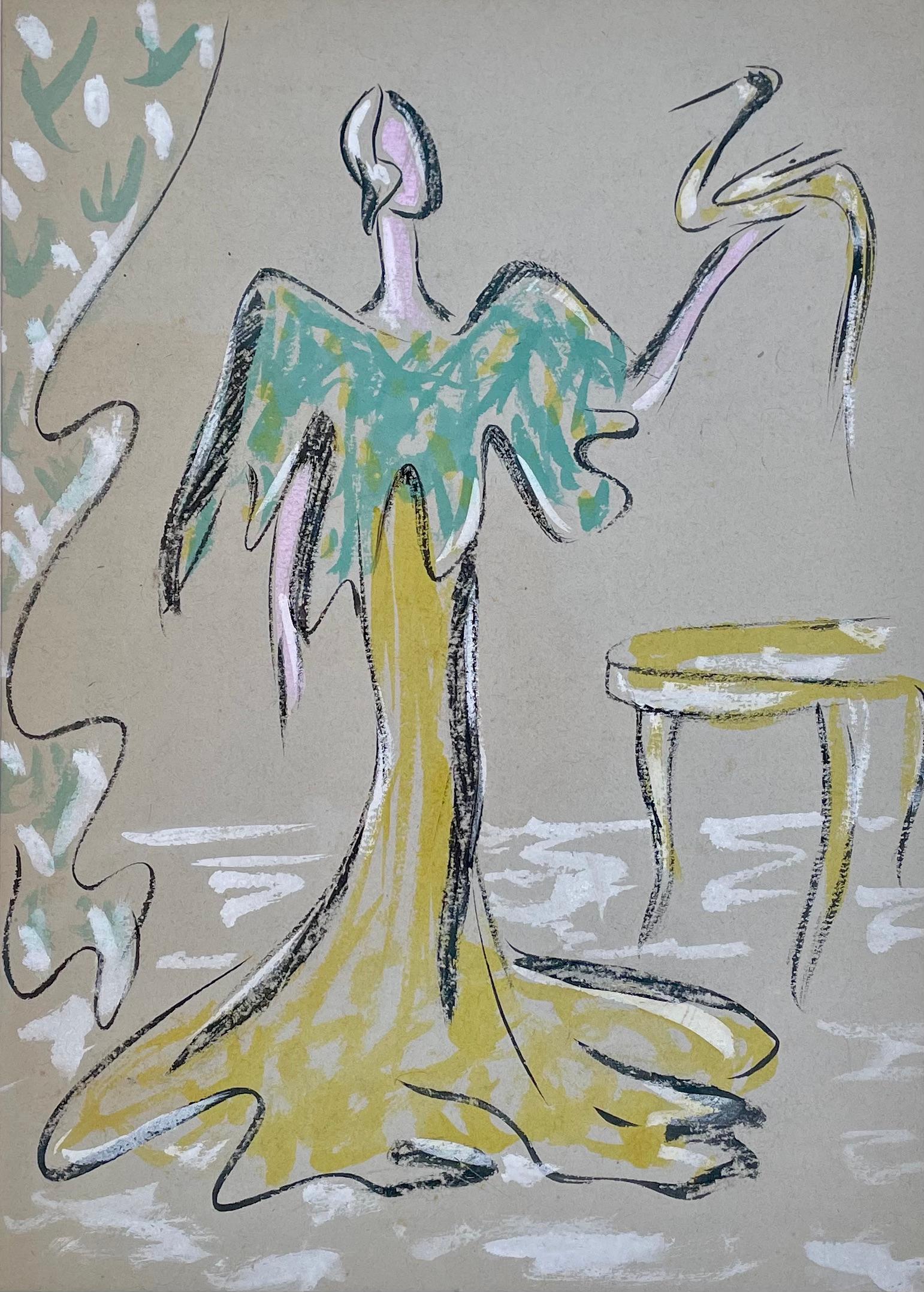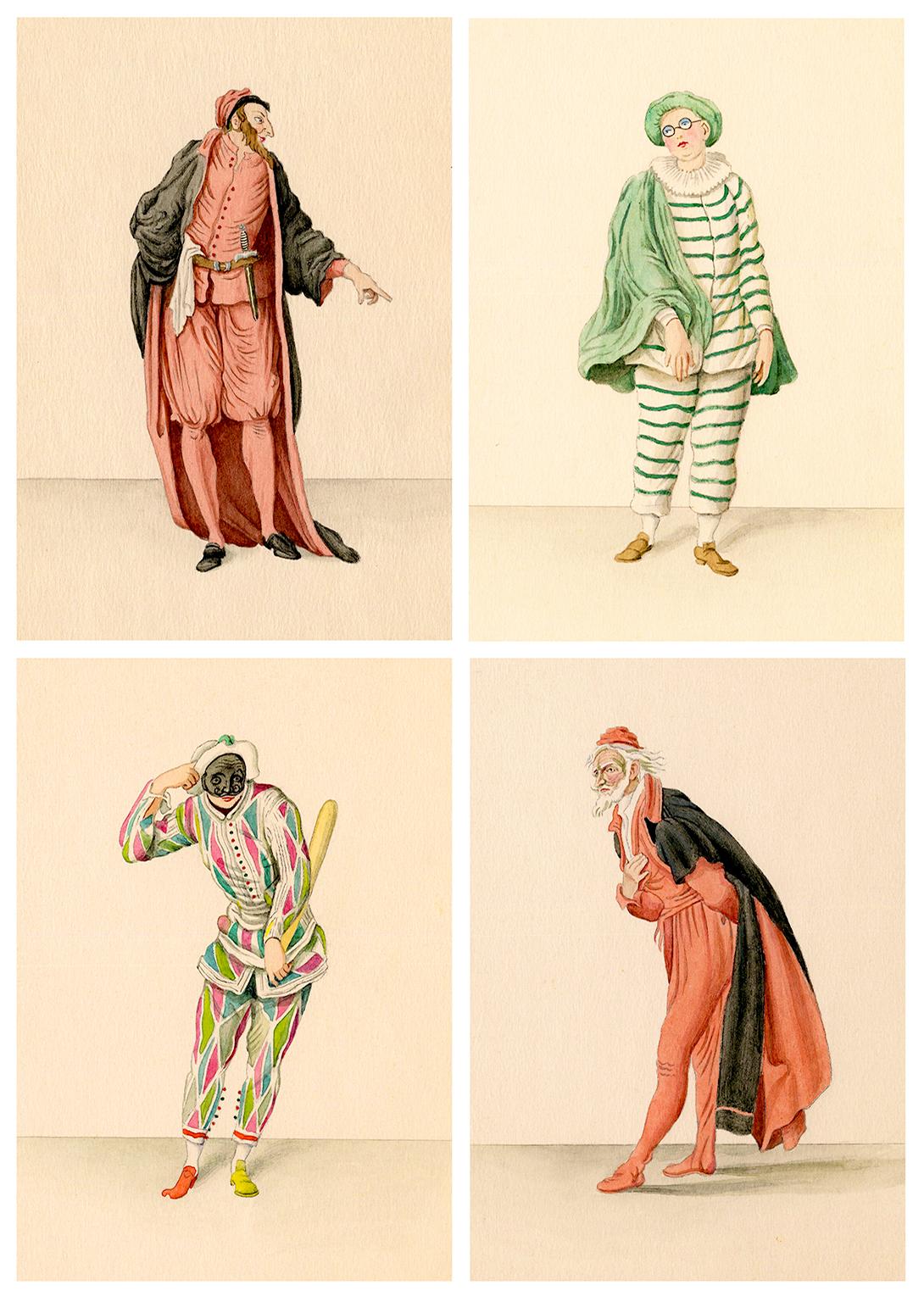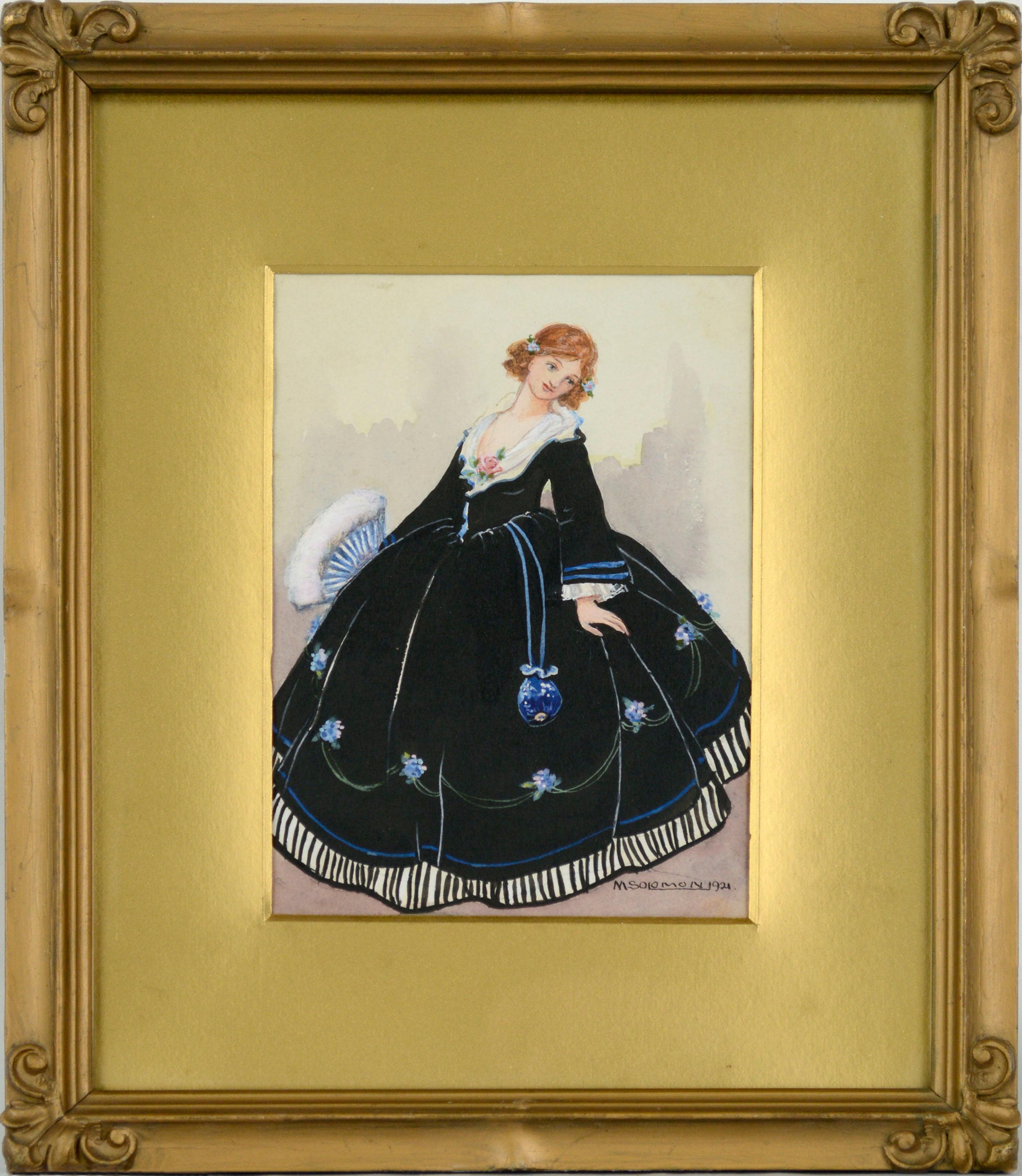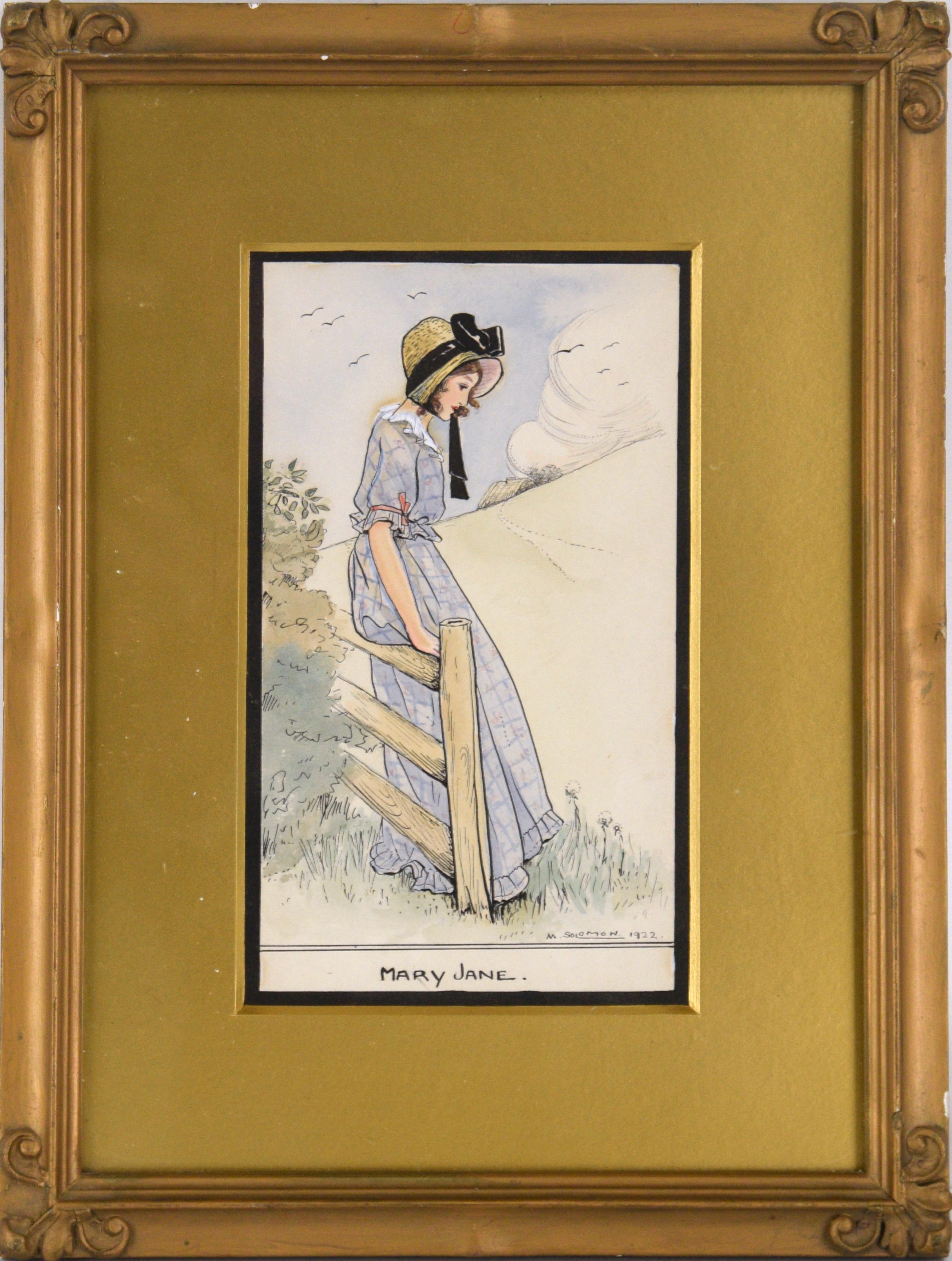Items Similar to "Flamenco Avec Rosario" (Florence Perez Padilla)
Want more images or videos?
Request additional images or videos from the seller
1 of 10
Jean Target"Flamenco Avec Rosario" (Florence Perez Padilla)c.1945
c.1945
About the Item
This artwork titled "Flamenco Avec Rosario" referring to the famous Flamenco dancers, Antonio Ruiz Soler and Florence Perez Padilla A.K.A Rosario, c.1945 is a watercolor, pastel and crayon on paper by noted French artist Jean Target, 1910-1997 It is signed at the lower right corner by the artist. The artwork size is 12.25 x 9.25 inches, framed is 21.35 x 18.15 inches. it is beautifully custom framed in a wooden gold frame, with matting and gold color spacer. it is in excellent condition, the colors are fresh and bright.
About the artist.
Jean Target was born in France in 1910. From a very young age early on, he was impassioned by the two forms of art that would remain the focal point of his career for all his life: visual arts and performing arts. In the 30s and 40s, as a young man, Jean Target frequented the Parisian theaters and cabarets, just like his role model, the famous impressionist painter Toulouse Lautrec, did at the end of the 19th century. Jean became friends with many performers and captured many formal as well as candid depictions. He gained exclusive access and used this privilege to create art with unparalleled perspective as an insider to the seedy, dark, yet glamorous underworld of Parisian cabaret. He drew the dancers on-site, capturing the dancer’s movements in his immediately recognizable signature style. In the 40s and 50s, he continued his artistic career, gaining recognition among collectors in France and all over Europe. His work depicting the Parisian performing art scene captures the feeling and history of the the theater and golden age of cabaret in Paris. Jean Target continued to draw, paint and sculpt until his death in 1997. The work of Jean Target is held in collections and museums worldwide including the world renowned Victoria And Albert Museum in London.
About the subject.
Antonio Ruiz Soler (4 November 1921, Seville – 6 February 1996, Madrid), was a Spanish flamenco dancer, choreographer and dance director. He was professionally known as Antonio or Antonio el Bailarín ("Antonio the dancer"). With Rosario (Florence Pérez Padilla) he had a partnership which lasted from 1928 until 1952 and which became world-famous. They were billed as Rosario y Antonio.
During appearances in the United States he danced in Ravel's "Boléro" in New York City and appeared in several Hollywood movies, including "Ziegfeld Girl" (1941), "Hollywood Canteen" (1944) and "Honeymoon" (1947).
In 1953 he formed his own Spanish ballet company, Antonio y los Ballets de Madrid, and Rosario also formed a company, partnered by Iglesias. Antonio choreographed many works in Spanish and classical style; several were taken up by other companies.
The Spanish flamenco dancer and choreographer Antonio Ruiz Soler, whose ballet-inspired footwork and arm movements brought new prominence to male dancers on the Spanish stage in the 1940's, 50's and 60's, died on Monday at his home in Madrid. He was 74.
The Associated Press reported that he died of a stroke after a period of poor health.
For three decades starting in the 1940's, the man nicknamed "Antonio el Bailarin" ("Antonio the dancer") was credited with breaking new ground, first as a confidant and elegant dancing partner to his cousin Florencia Perez, known as Rosario, and later as a choreographer influenced by Balanchine.
He created choreography for Falla's "Three-Cornered Hat," Rodrigo's "Concierto Andaluz" and Albeniz's "Suite Iberica."
During appearances in the United States that drew large, enthusiastic crowds, he danced in Ravel's "Bolero" in New York City and appeared in several Hollywood movies, including "Ziegfeld Girl" and "Honeymoon."
Mr. Ruiz Soler's last performance as a dancer was in Sapporo, Japan, in 1979.
Born in Seville in 1921, he began studying dance at age 6. Early in his career, he toured for a decade in Argentina and throughout North and South America, returning to Spain in 1949.
His flamenco partnership with his cousin Rosario gained a following on both sides of the Atlantic. They were a stage attraction for 22 years, until they split up in 1952; they reunited from 1962 to 1965.
In the 1950's, Mr. Ruiz Soler formed his own dance company in Spain. As a choreographer, "he modernized Spanish ballet, adding theatrical touches," said Roger Salas, dance critic of the Madrid daily El Pais. But his emphasis on pirouettes and his attention to costumes and sets led some flamenco purists to criticize his work, Mr. Salas said.
Rosario's real name was Florencia Pérez Padilla. She was born in Seville in 1918. At the age of nine she attended the academy of the dance master Realito, where she met Antonio el Bailarín, who was six at the time. Realito brought them together as dance partners and they launched their artistic career in 1928 with a performance in the Spanish pavilion at the International Exhibition in Liège. From that point they embarked on a world tour under the artistic name of 'Los chavalillos sevillanos', with a repertoire which covered various different styles of Spanish dance. Rosario also studied with the Pericet family, La Macarrona and Vicente Reyes, with whom she began to dance classical choreographies. After her artistic separation from Antonio in 1953, she set up her own company. In 1962 they were reunited again, and from that time on she gave occasional performances as a guest artiste in Antonio el Bailarín's own company. In 1971 she retired from the stage and dedicated herself to teaching in her private school. She died in Madrid in 2000.
- Creator:Jean Target (1910 - 1997)
- Creation Year:c.1945
- Dimensions:Height: 21.35 in (54.23 cm)Width: 18.15 in (46.11 cm)Depth: 0.65 in (1.66 cm)
- Medium:
- Movement & Style:
- Period:
- Condition:
- Gallery Location:San Francisco, CA
- Reference Number:
About the Seller
5.0
Platinum Seller
These expertly vetted sellers are 1stDibs' most experienced sellers and are rated highest by our customers.
Established in 1999
1stDibs seller since 2017
691 sales on 1stDibs
Typical response time: 1 hour
- ShippingRetrieving quote...Ships From: San Francisco, CA
- Return PolicyA return for this item may be initiated within 7 days of delivery.
More From This SellerView All
- La Jeune Danseuse Espagnole Rosita Rivera, Dans la Danse du FeuLocated in San Francisco, CAThis artwork titled "La Jeune Danseuse Espagnole Rosita Rivera, Dans la Danse du Feu" c.1945 is a watercolor, pastel and black stone on paper by noted French artist Jean Target, 1910...Category
Mid-20th Century Realist Figurative Drawings and Watercolors
MaterialsWatercolor
- Danse populaire des Isles Canaries (Dance Popular from the Canaries Islands)Located in San Francisco, CAThis artwork titled "Danse populaire des Isles Canaries" (Dance Popular from the Canaries Islands) c.1950 is a watercolor, pastel and black stone on pap...Category
Mid-20th Century Realist Figurative Drawings and Watercolors
MaterialsWatercolor
- Alexander Grant, Dans Mam'zelle AngotLocated in San Francisco, CAThis artwork titled "Alexander Grant, Dans Mam'zelle Angot" referring to the famous ballet dancer, Alexander Grant, c.1950 is a watercolor, pastel and crayon on brown paper by noted French artist Jean Target, 1910-1997 It is signed and titled at the lower right corner by the artist. The artwork size is 11.75 x 9 inches, framed is 20.75 x 17.5 inches. it is beautifully custom framed in a dark wood frame, with matting and gold color spacer. it is in excellent condition, the colors are fresh and bright. About the artist. Jean Target was born in France in 1910. From a very young age early on, he was impassioned by the two forms of art that would remain the focal point of his career for all his life: visual arts and performing arts. In the 30s and 40s, as a young man, Jean Target frequented the Parisian theaters and cabarets, just like his role model, the famous impressionist painter Toulouse Lautrec, did at the end of the 19th century. Jean became friends with many performers and captured many formal as well as candid depictions. He gained exclusive access and used this privilege to create art with unparalleled perspective as an insider to the seedy, dark, yet glamorous underworld of Parisian cabaret. He drew the dancers on-site, capturing the dancer’s movements in his immediately recognizable signature style. In the 40s and 50s, he continued his artistic career, gaining recognition among collectors in France and all over Europe. His work depicting the Parisian performing art scene captures the feeling and history of the the theater and golden age of cabaret in Paris. Jean Target continued to draw, paint and sculpt until his death in 1997. The work of Jean Target is held in collections and museums worldwide including the world renowned Victoria And Albert Museum in London. About the subject. Alexander Grant was born on February 22 1925 in Wellington, New Zealand, the son of hoteliers. He was one of two brothers who would become major names in the Royal Ballet: Garry Grant, 15 years younger than Alexander, later took over many of his parts. Alexander resolved to become a dancer when he was six. Inspired by the rare tours of Russians migrant to the islands, he studied ballet at Wellington College, and won a scholarship to the Sadler’s Wells Ballet School in 1944. Because it was wartime, the London company was short of men, and Grant was swiftly taken into the company itself. Two years later the former Diaghilev choreographer Léonide Massine came to London to stage Mam’zelle Angot, decorated by André Derain. Massine seized on Grant for the virtuosic central role of the amorous Barber, and it made the young dancer a star. Massine and Grant had much less success with a Scottish-themed follow-up, Donald of the Burthens, designed and composed by Scottish artists, with Grant as the kilted Donald threatened by Beryl Grey as the figure of Death. Above all Grant’s distinction as a classical dancer, combined with his mastery of character, enabled Ashton to develop what were usually subsidiary supporting roles – the bravura trick soloists – into key players in the main drama, often introducing a provocative sexual charge. As a young man Grant was lusted after by both sexes, as well as by Ashton himself. As the Pirate Chief in Daphnis and Chloe (1951), the dancer described his orders: “I used to have to rush on stage, pick Margot up with one hand and run off with her, and then ... swing her round and round, throw her on the floor and proceed to jump all over her.” The swooning fans who gathered at the stage door to catch a glimpse of him were astonished to find how short he was. In Sylvia (1952) he had to stand immobile through most of Act 1, resembling a naked stone statue of the love-god Eros; when he suddenly moved, it created a shock much enjoyed by the audience. Ashton then cast him as the sailor hero of a Madam Butterfly-like ballet, now lost. This was Madame Chrysanthème, with an Alan Rawsthorne score and a Nagasaki setting, in which Grant’s insouciance underscored the tragedy of the Japanese geisha whom he betrayed. In 1957 Grant was closely involved with the gestation of Ashton’s ballet Ondine, as the composer, Hans Werner Henze, stayed in his Battersea house while Ashton and Grant worked on what would be a very radical rewriting of the classical ballet idea. Grant himself danced the Mediterranean Sea god Tirrenio, in a stormy whirl of green seaweed-like costume ravishingly designed by Lila de Nobili. His superb incarnation of the puppet Petrushka and his eccentric Dr Coppelius in Coppelia laid the foundation for the two most famous character roles Ashton then created for him: as the capering halfwit Alain in La Fille mal gardée (1960), and Bottom the Weaver in The Dream (1964). In the first, sporting top knotted hair, he turned gawky cartwheels and conveyed a vain hope of love, finding solace in his red umbrella when spurned. In the second he turned a few short minutes, as Bottom wears a donkey’s head and capers about in pointed shoes, into a cameo of great pathos as well as comedy. When Ashton died he bequeathed the ownership of La Fille mal gardée to Grant, and its popularity kept him busy staging it globally, from the Bolshoi Ballet to the National Ballet of Canada, where he was artistic director from 1976 to 1983. Grant continued to perform character roles created for him by Ashton, requiring less active dancing but no less powerful style. He was the blustering William Meath Baker in Enigma Variations (1968) and the dejected husband Yslaev in A Month in the Country (1976), opposite Lynn Seymour. Arguably, the frequency and power with which “older man” roles recurred in British choreography by Ashton and his successor Kenneth MacMillan could be traced to the conviction and stage presence brought to bear by Grant. He was a keen collaborator on Ashton’s 1971 film Tales of Beatrix Potter, in which he performed Pigling Bland, repeating his feat from The Dream by dancing on point while wearing an enormous animal head. The following year, Grant became director of the Royal Ballet’s outreach wing, Ballet For All, and was asked to take over leadership of the National Ballet of Canada four years later. There he was sometimes accused of overloading the repertoire with Ashton ballets, but by the time he left in 1983 the Canadian Ballet also had a wide international modern ballet repertoire that included work by Kenneth MacMillan, Maurice Béjart, Jerome Robbins and rising home-grown talent such as the later NBC director James Kudelka. On his return to Britain, Grant was an extremely popular guest, in 1984 dancing the Dago in Ashton’s evergreen early hit Façade at the choreographer’s 80th birthday gala at Covent Garden. Grant also had character roles with London Festival Ballet, such as Dr Drosselmeyer in The Nutcracker and Madge the Witch in La Sylphide. During the years they worked together, Ashton made numerous roles for Grant. Among them are the following. 1946. Les Sirènes, music by Lord Berners. Role: "the boy who jumps through a hoop." 1946, The Fairy Queen, masque produced by Ashton and Malcolm Baker-Smith, music by Henry Purcell, adapted by Constant Lambert. Role: a Savage. 1948. Scènes de Ballet, music by Igor Stravinsky. Role: principal dancer. 1948. Cinderella, music by Sergei Prokofiev. Role: The Jester. 1951. Daphnis and Chloë, music by Maurice Ravel. Role: Bryaxis, a pirate chief. 1952. Sylvia, music by Léo Delibes. Role: Eros, god of love. 1952. Le Lac des Cygnes...Category
Mid-20th Century Realist Figurative Drawings and Watercolors
MaterialsWatercolor
- Danse Espagnole, Teresa Viera RomeroLocated in San Francisco, CAThis artwork titled "Danse Espagnole" referring to the famous Flamenco dancers, Teresa Viera Romero, is a watercolor, on paper by noted French artist Jean Target, 1910-1997 It is sig...Category
Mid-20th Century Realist Figurative Drawings and Watercolors
MaterialsWatercolor
- Les Danseurs Espagnols Teresa and LuisilloLocated in San Francisco, CAThis artwork titled "Les Danseurs Espagnols Teresa an Luisillo" referring to the famous Flamenco dancers, Teresa Viera Romero and Luis Perez Davila A.KA Luisillo, is a watercolor, on...Category
Mid-20th Century Realist Figurative Drawings and Watercolors
MaterialsWatercolor
- "Am I Excluded ? or do I Exclude Myself ?" Large colored ink and watercolorLocated in San Francisco, CAThis artwork titled "Am I Excluded ? or do I Exclude Myself ?" 1979, is a colored ink and watercolor on Fabriano paper by American artist Linda Carter Hol...Category
Late 20th Century Realist Figurative Drawings and Watercolors
MaterialsWatercolor
You May Also Like
- The Gown - 1930s British theatrical costume design by John DronsfieldBy John DronsfieldLocated in London, GBJOHN DRONSFIELD (1900-1951) Yellow and Green Gown Watercolour and chalk Unframed 38 by 27.5 cm., 15 by 11 in. (mount size 59 by 47 cm., 23 ¼ b...Category
Early 20th Century Realist Figurative Drawings and Watercolors
MaterialsWatercolor
- "Elie", Trees Inhabited by Human in Nature, Pigments Ink Drawing on PaperBy Frank GirardLocated in Clermont-Ferrand, Auvergne-Rhône-AlpesThis drawing by Frank Girard is created with pigments, Chinese ink, watercolors, acrylic, and colored pencils on 300g/m2 neutral white paper. It is not framed. Through drawings, the...Category
2010s Realist Figurative Drawings and Watercolors
MaterialsPaper, Ink, Acrylic, Watercolor, Color Pencil, Pigment
- Commedia dell'arte – Four Character Studies in Watercolor, 1920sLocated in Myrtle Beach, SCUnidentified artist, 'Commedia dell’arte' – four character studies (Arlecchino, Pantalone, Pantalone giovane, Tartaglia), watercolor and pencil, c. 192...Category
1920s Realist Figurative Drawings and Watercolors
MaterialsPencil, Watercolor
- English tea Clipper ship in full sail at sea with the Sun risingLocated in Woodbury, CTVery Well painted English Tea Clipper in full sail at sea during Sunrise. Allan was a mid 20th century English marine painter. This is a very fine exam...Category
1930s Realist Figurative Drawings and Watercolors
MaterialsGouache
- 1920's Illustration of a Country GirlLocated in Soquel, CAFinely detailed figurative illustration of a young woman leaning against a fence. The woman is wearing a plaid dress and bonnet with a black ribbon. Some of the landscape has been il...Category
1920s Realist Figurative Drawings and Watercolors
MaterialsInk, Gouache, Paper, Watercolor
- 1920's Historical Fashion Illustration of Lady in 17th Century DressLocated in Soquel, CAFinely detailed historical figurative fashion illustration painted in watercolor in 1921, of a lady in 17th century dress; complete with a full blac...Category
1920s Realist Figurative Drawings and Watercolors
MaterialsPaper, Watercolor
Recently Viewed
View AllMore Ways To Browse
Florence Art Scenes
Vintage Target
Vintage 50s Drawings
Set Of 6 Drawings
American 19th Century Watercolors
19th Century European Watercolor
Paris 1940s Watercolor
Flamenco Art
Spanish Flamenco
Flamenco Dancer
Seville Spain Paintings
Dancer Dance Cabaret
Vintage Flamenco
60s Painting Impressionist
Vintage Break Dancing
Vintage Dancer Hats
Vintage Japanese Hat
Sapporo Vintage





